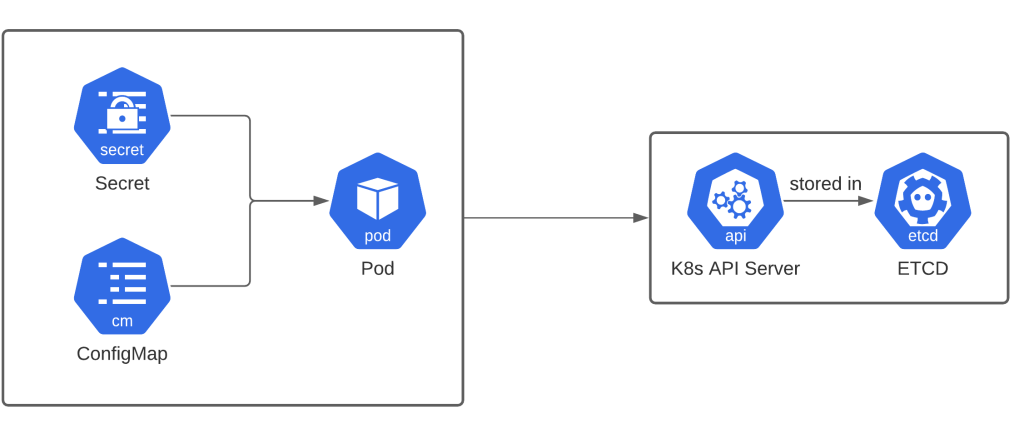🚀 Mastering ConfigMaps and Secrets in Kubernetes.
 Apurva Gargote
Apurva Gargote
1️⃣ Task: Creating a ConfigMap
📝 Method 1: Using a YAML File
Create a file named configmap.yml and add the following content:
apiVersion: v1
kind: ConfigMap
metadata:
name: my-config # Name of the ConfigMap
data:
APP_ENV: "production" # Environment setting
LOG_LEVEL: "debug" # Logging level
📌 Explanation:
apiVersion: v1→ Specifies the Kubernetes API version.kind: ConfigMap→ Defines that this is a ConfigMap.metadata.name: my-config→ Assigns a name to the ConfigMap.data→ Stores key-value pairs used for configuration.
🔹 Apply the ConfigMap using the command:
kubectl apply -f configmap.yml -n <namespace-name>
📌 What this does:
- Applies the
configmap.ymlfile to the specified namespace in Kubernetes.
📝 Method 2: Using the Command Line
If you don’t want to create a file, you can create a ConfigMap directly with this command:
kubectl create configmap my-config --from-literal=APP_ENV=production --from-literal=LOG_LEVEL=debug -n <namespace-name>
📌 Explanation:
kubectl create configmap→ Command to create a ConfigMap.my-config→ Name of the ConfigMap.--from-literal=APP_ENV=production→ Directly sets a key-value pair (APP_ENV=production).-n <namespace-name>→ Specifies the namespace where the ConfigMap will be created.
🔎 Verify that the ConfigMap is created
kubectl get configmaps -n <namespace-name>
📌 Shows a list of ConfigMaps in the specified namespace.
kubectl describe configmap my-config -n <namespace-name>
📌 Displays details about the my-config ConfigMap.
2️⃣ Task: Using the ConfigMap in a Deployment
Modify your deployment.yml file to use the ConfigMap:
apiVersion: apps/v1
kind: Deployment
metadata:
name: my-app
spec:
replicas: 2
selector:
matchLabels:
app: my-app
template:
metadata:
labels:
app: my-app
spec:
containers:
- name: my-container
image: nginx
envFrom:
- configMapRef:
name: my-config # Using the ConfigMap in the container
📌 Explanation:
envFrom.configMapRef.name: my-config→ Loads all key-value pairs from the ConfigMap into environment variables for the container.
🔹 Apply the updated Deployment
kubectl apply -f deployment.yml -n <namespace-name>
3️⃣ Task: Creating a Secret
📝 Method 1: Using a YAML File
Create a file named secret.yml:
apiVersion: v1
kind: Secret
metadata:
name: my-secret
type: Opaque
data:
DB_PASSWORD: cGFzc3dvcmQ= # Base64 encoded password (password)
📌 Encoding the Secret in Base64
Run the following command in your terminal to generate the Base64-encoded password:
echo -n "password" | base64
✅ Example Output:
cGFzc3dvcmQ=
📌 Explanation:
kind: Secret→ Defines that this is a Secret.type: Opaque→ Specifies an arbitrary secret type.data.DB_PASSWORD: cGFzc3dvcmQ=→ Base64-encoded value for password (passwordencoded in Base64).
🔹 Apply the Secret
kubectl apply -f secret.yml -n <namespace-name>
📝 Method 2: Using the Command Line
kubectl create secret generic my-secret --from-literal=DB_PASSWORD=password -n <namespace-name>
📌 Explanation:
kubectl create secret generic→ Creates a generic Secret.my-secret→ Name of the Secret.--from-literal=DB_PASSWORD=password→ Adds a key-value pair withDB_PASSWORD=password.Kubernetes automatically encodes the value in Base64.
🔎 Verify that the Secret is created
kubectl get secrets -n <namespace-name>
📌 Lists all Secrets in the namespace.
kubectl describe secret my-secret -n <namespace-name>
📌 Shows detailed information about the Secret.
4️⃣ Task: Using the Secret in a Deployment
Modify your deployment.yml file:
apiVersion: apps/v1
kind: Deployment
metadata:
name: my-app
spec:
replicas: 2
selector:
matchLabels:
app: my-app
template:
metadata:
labels:
app: my-app
spec:
containers:
- name: my-container
image: nginx
env:
- name: DB_PASSWORD
valueFrom:
secretKeyRef:
name: my-secret # Using the Secret in the container
key: DB_PASSWORD
📌 Explanation:
env.name: DB_PASSWORD→ The environment variable inside the container.valueFrom.secretKeyRef.name: my-secret→ Refers to the Kubernetes Secret namedmy-secret.valueFrom.secretKeyRef.key: DB_PASSWORD→ Uses theDB_PASSWORDkey from the Secret.
🔹 Apply the updated Deployment
kubectl apply -f deployment.yml -n <namespace-name>
Subscribe to my newsletter
Read articles from Apurva Gargote directly inside your inbox. Subscribe to the newsletter, and don't miss out.
Written by

Apurva Gargote
Apurva Gargote
👨💻 Last-year student diving deep into DevOps, Cloud Engineering, and Infrastructure Automation. Passionate about building scalable, efficient, and secure systems. Let’s connect and build something amazing! 🚀